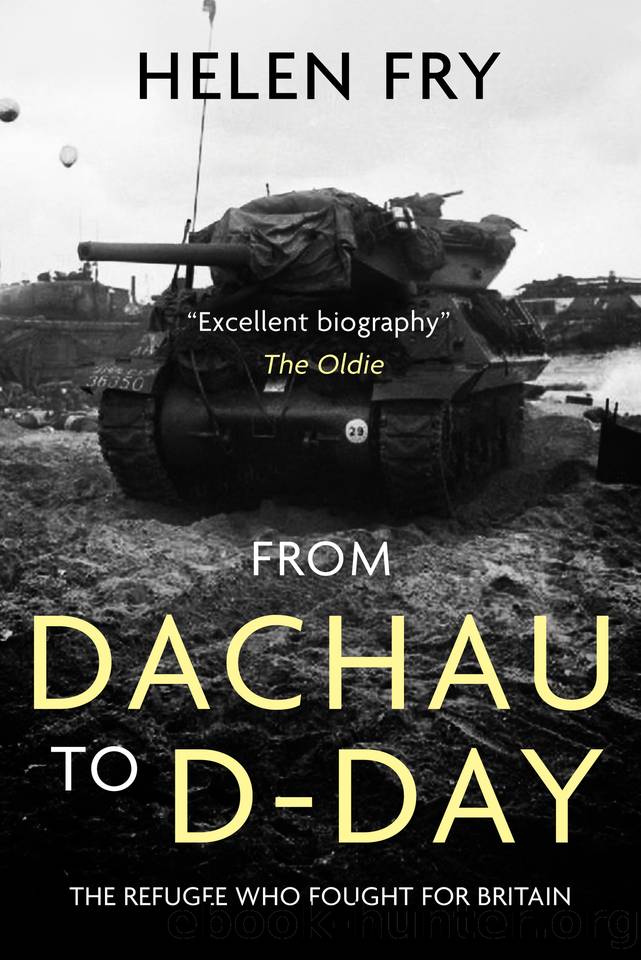From Dachau to D-Day by Fry Helen

Author:Fry, Helen [Fry, Helen]
Language: eng
Format: epub
Publisher: Lume Books
Published: 2020-12-19T16:00:00+00:00
Chapter 7
Advance through Belgium and Holland
On the afternoon of 12 September 1944, after a day spent on re-fitting and maintenance, the 8th Hussars moved to an area east of Mâlines (Mechelen) in Belgium where the enemy did little except send out random artillery and mortar fire. The following day arrangements were made to send relief parties into the capital Brussels. By now 11th Hussars, also working in the region of 8th Hussars, held a position watching the line of the Canal de Jonction between Antwerp and Lierre. The next objective was to push towards Holland and cross the border. On 15 September the regiment advanced towards Lierre and two days later on 17 September, heavy enemy mortar fire caused two casualties in C Squadron. Orders were received for the next move. The following day on 18 September, according to the war diaries, the regiment set off at 7.20a.m on a route from Lierre to Konings-Hooikt and Booischot. C Squadron was ordered to move to the area of Boekel. There was little enemy activity, although the Germans were still occupying Herentals. On 21 September, orders were received to extend eastwards. The following day, a troop of C Squadron came across four American airmen who had baled out of their planes and evacuated them. Now Willy waited with the rest of C Squadron to advance on Eindhoven in Holland. On 24 September, they were finally given orders to advance on Schijndel, situated north of Eindhoven and south of SâHertogenbosch. The following day, C Squadron cleared woods en route and led the way on the main road to Schijndel. The war diaries record that: âregiment captured an enemy ambulance, knocked out three enemy transports and two 88mm anti-tank guns.â
On 26 September, patrols from C Squadron went forward to harass the enemy, overrunning several positions and taking fifteen German POWs. The war diaries record that: âthe forward squadrons received heavy mortar and shellfire from the enemy, and several casualties caused.â One of those casualties was Willy. His tank received a direct hit and was knocked out. He describes that dreadful day in which he was the sole survivor of his crew:
âWe were heading towards Nijmegen and told that we should take a railway line. My tank was the lead tank. It was never a good thing for us to be at the front, because naturally the life expectancy of a leading tank was always very short. We saw the railway line ahead of us from quite a long distance. We stopped next to a haystack and my Commander said that he had seen some movement ahead in the bushes. He suggested that we stay put until we knew exactly what was happening ahead. The next thing we heard was the haystack receiving a trace of bullets from the Germans. It caught fire immediately. It was so hot and bad that we could not stay with our tank next to the haystack so we had to move. The next thing I can remember was the turret of my tank being hit by an 88mm gun from a German anti-tank gun.
Download
This site does not store any files on its server. We only index and link to content provided by other sites. Please contact the content providers to delete copyright contents if any and email us, we'll remove relevant links or contents immediately.
Blood and Oil by Bradley Hope(1514)
Wandering in Strange Lands by Morgan Jerkins(1359)
Ambition and Desire: The Dangerous Life of Josephine Bonaparte by Kate Williams(1329)
Daniel Holmes: A Memoir From Malta's Prison: From a cage, on a rock, in a puddle... by Daniel Holmes(1283)
It Was All a Lie by Stuart Stevens;(1243)
Twelve Caesars by Mary Beard(1232)
The First Conspiracy by Brad Meltzer & Josh Mensch(1124)
What Really Happened: The Death of Hitler by Robert J. Hutchinson(1114)
London in the Twentieth Century by Jerry White(1098)
Time of the Magicians by Wolfram Eilenberger(1074)
Twilight of the Gods by Ian W. Toll(1072)
The Japanese by Christopher Harding(1068)
Cleopatra by Alberto Angela(1045)
A Woman by Sibilla Aleramo(1042)
Lenin: A Biography by Robert Service(1028)
The Devil You Know by Charles M. Blow(973)
Reading for Life by Philip Davis(956)
1965--The Most Revolutionary Year in Music by Andrew Grant Jackson(910)
The Life of William Faulkner by Carl Rollyson(904)
